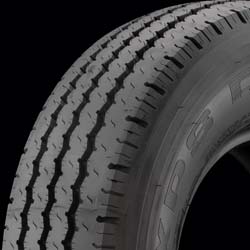The proper rotation pattern for a rear wheel drive truck using 4 identical tires is the rearward cross pattern.
This helps round out any cupping or uneven wear usually associated with vans and trucks which usually are well loaded with a rear weight bias.
Right Rear tire moves to the Right Front position.
Left Rear tire moves to the Left Front position.
Left Front tire moves to the Right Rear position.
Right Front tire moves to the Left Rear position.
Another solution to prevent uneven wear to the front tires is to buy tires with a continuous rib rather than individual tread blocks.
These should not be used where snow may be encountered.

Keeping correct tire pressure will also go a long way towards prolonging the life of your tires.
The correct pressure is found on the label usually inside one of the door edges or glove box.
Use this as a starting point and check tires frquently for uneven wear. If the tires are wearing more near the center of the tread you are overinflated while if they are wearing out more along the inside and outside edges the tires are underinflated.






 Reply
Reply










